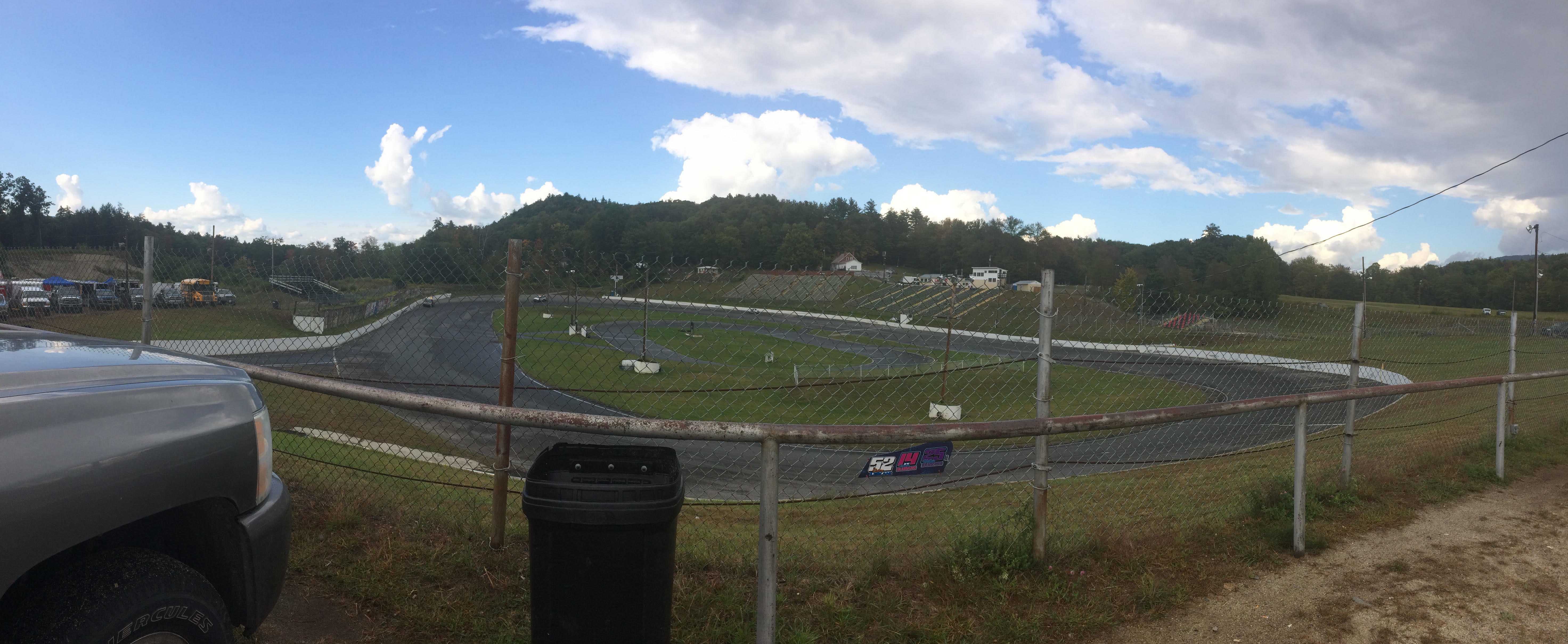
Early last week, I was asked to attend an event at Claremont Speedway, a racetrack that I had (surprisingly) never visited before. Taking a trip to an undiscovered-by-you racetrack is always exciting, so I decided to jump on the opportunity.
Through my research I did in the days leading up to the event, I realized that Claremont was in Western New Hampshire, nearly three hours from where I’m located in Maine. Although enthusiastic about the opportunity, I was not-so-enthusiastic about the drive to and from. One of my good racing friends, Seth Drown, is a North East Mini Stock Tour competitor in his first year of competition in the series. He invited me to take the voyage with him and his one-man pit crew, giving me the opportunity to see the preparation required to help a driver get onto the track come race day.
Come early afternoon on race day, we were all loaded up and on the road. After almost 3 hours, our GPS told us that we were close; but we were all confused and thought we were lost, seeing that we had just driven through a residential neighborhood and were seemingly traveling down a back road. Out of nowhere, a sign for “Claremont Speedway” had surfaced amongst the trees and we had arrived. The track is located just 20 minutes from Springfield, Vermont and 90 minutes from New England’s home for racing, New Hampshire Motor Speedway. Upon arrival, all members of the track staff were helpful, signing in competitors and team members with ease. I arrived at the makeshift “credentials” window, giving Karen my name at the gate. Much to my surprise, she was aware of my visit and quickly signed me in and gave me a wristband with no trouble at all. Visiting a local short track that you have never visited before as “media” can sometimes be tough, seeing that you are not a familiar face that the track staff sees. But, between Toby Batchelder and Karen, it was easy for me. It surprised me when I realized how easy to contact the track is; their email is available right on their Facebook page and they are on it, quickly responding to inquiries and track questions.
The 1/3 mile asphalt oval has a unique layout and a Bristol-like feel. One thing that sets apart Claremont Speedway from the rest is that you can see everything happening on the track without having to leave your pit pad. The track is a fishbowl, where you can look down into the speedway from every angle. Although the track itself has similar traits to Bristol, the grandstand seating reminded me of that of Sonoma Raceway, where the grandstands are seemingly embedded into the land. Although Claremont has an old-school feel, the track is fully up-to-date on all social media platforms, utilizing Facebook, Twitter and even YouTube to stay in touch with their fans. The track’s weekly series takes place on Friday nights in the summer, with Modifieds, Super Streets, Limited Sportsman and Wildcats. It’s a family-friendly atmosphere with inexpensive food (I got a hot dog AND fries for only $4) and free admission for children under the age of 5. In addition to their weekly events, the track hosts special events from time to time, like the 4-Cylinder Nationals that took place last Friday.
In addition to being unfamiliar with Claremont Speedway, I was unfamiliar with the North East Mini Stock Tour coming into Friday. The tour was started by Bob Guptill, a former Mini Stock competitior. The tour is based out of Gray, Maine and was founded in 2008. The series had their first event in 2009, and it has been growing ever since. The tour has a handful of large sponsors on board, including Twisted Tea and Texas Roadhouse. The tour hosts 12 events throughout the year, running from late April until early October. Tracks included on the schedule include NHMS, Lee, Claremont, Waterford, Seekonk, Fair Haven and others. This year, the season kicked off at Lee Speedway and will conclude at Thompson Speedway Motorsports Park in the second week of October.
The division’s mission statement, as it’s posted on their social media, is “To provide cheap, fun racing and develop driving skills for moving up.” With racing being such a costly sport for everyone involved, it’s a breath of fresh air seeing a division of drivers working with cars that aren’t upper-tier cars price-wise, like Super Late Models and Late Sportsman Models that you can easily dump tens of thousands of dollars into every season. Safety is also a key factor: drivers are required to wear head and neck restraints in all NEMST-sanctioned events. Although helmets are required at every track, neck restraints (not just neck rolls) aren’t enforced at every race track. In addition, each driver is required to have an AMB transponder on their car during competition. This allows the event organizers to track lap times used to set provisionals if need be.
The Mini Stock Tour is no joke; seeing the process of qualifying heats reminded me of being at PASS Weekend or the Oxford 250. On event day, 39 cars from all over New England showed up, attempting to be one of the final 27 cars that would make it into the big show. NEMST sold individual laps for $20 a piece; a similiar lap-winnings format to what is used every year for the Oxford 250. Chasing the Checkered got its hands on lap 72, while other people like Mike Twist and Speed51 stepped up to sponsor laps as well. These lap earnings would be added to the winner’s pot, giving them the chance to win over $3,500 in prize money, including the automatic $1,500 that was distributed to the winner.
I was able to attend my first official drivers meeting, which was interesting to be a part of. Driver meetings are typically restricted to each driver and one team representative, which is typically their crew chief. Since I was an acting member of the #16 crew on Friday, I got to stand back and watch what actually goes down in a drivers meeting, which is more informal than anything. Drivers were thanked by Bob Guptill for making a big show and being a part of the tour. Rules were discussed, such as what will and will not be tolerated on the track. “Dive Bombs” were discussed, a form of dirty racing where drivers ride up on another driver, cutting off their line completely. Other details were discussed, like where qualifying drivers need to park once their heat is finished, how winnings would be distributed, what channel to tune their radios into, essentially all the small details that would help the big show run smoothly.
Soon after the drivers meeting, the qualifying races began. Four 10-lap heat races kicked off the competition, where the top four drivers from each heat would advance to the big 100-lap feature. They were followed by two 15-lap consolation races, where the top 4 from each would advance once again. Finally, a last chance race took places, where the 3 top finishers would advance to the big show.
Unfortunately, this is where the night would come to an end for the #16 team. After being plagued with unexpected electrical issues all afternoon, the #16 just couldn’t get going enough to advance into the big show. With racing comes a lot of triumphs and a lot of heartbreak, but there are always more weeks ahead where a driver can improve and really tune into their car. Seth said that he “knew that it could go 50/50”, but he knew that if he didn’t at least make the trip and attempt to qualify, he would have regretted it and would have been beating himself up. It was inspiring to see how other drivers and teams were there to not only work on their own cars, but to help other drivers and teams when they needed it. The driver who found home on the pit pad next to the #16 helped push Seth back onto his pit pad, attempting to help him resolve electrical issues, offered tools and more. The “racing family” is just that: one big family. As soon as drivers put their helmets on, it’s all business. But, in the pits, drivers and their respective teams do nothing but lean on each other for support and provide both wisdom and resources to anyone that is in need. It’s a wonderful thing to be a part of and to witness week in & week out.
Glen Thomas went on to lead 70 laps and win the 100-lap feature, taking home $3,060 in prize money.
The NEMST staff was very hands-on and helpful to all drivers and teams. As soon as cars unloaded, a tour representative came over to nearly every competitor’s car to remind them to check certain specifics, like ride height. This really assisted in helping drivers be more prepared coming into the scales, but most importantly, this helped the process flow more smoothly and be more time-efficient for not just the drivers and teams, but the tour staff as well.
In the end, I was very grateful to be able to visit a new track and explore a new racing series that I had never explored before. Not only was the track staff more than friendly and courteous, the entire NEMST team helped shed light on what racing is all about; which is having fun, being respectful toward other competitors and working hard to improve driving skills for future success in the sport.
I’d like to thank Claremont Speedway for allowing me to come out to the event, Seth Drown for allowing me to be a small part of the #16 crew and NEMST for putting on such an exciting show for the fans.
Check out the North East Mini Stock Tour’s final event on Saturday, October 14th — a 20-lap shootout at Thompson Speedway Motorsports Park as part of the 55th Annual Sunoco World Series of Speedway Racing.
